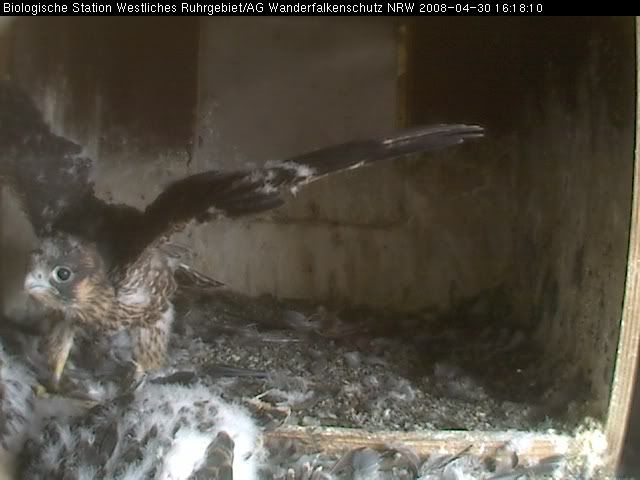
Nightfall in Oberhausen Germany with magnificent colors


This keeps amazing me daily. The photo's are so awesome. These chicks are growing into real juvi's. The females are turning brown now as well. And all three are exploring the ledge. And excersing their wings frequently. You can see very well now, how the feathers are breaking through two kinds of down. The real one that will stay on and forms the warm and isolating underlayers on the skin. And the down that sticks to the top of the feathers and was pushed out of the feather follicle.
Feather anatomy
Feathers are made out of keratin, the same protein found in hair and nails. Feathers have a central shaft. The smooth, unpigmented base, which extends under the skin into the feather follicle, is called the calamus. The portion above the skin, from which the smaller barbs or branches extend, is termed the rachis or scapus. On each side of the rachis there is a set of filaments, called barbs, which come off at approximately a 45º angle. This portion of the feather that has barbs is called the vane. In the larger feathers, these barbs have two sets of microscopic filaments called barbules. Barbules from one barb cross the adjacent barbs at a 90º angle. Barbules, in turn, have hooklets, sometimes called hamuli or barbicels, which hook the barbules together, like a zipper, forming a tight, smooth surface. These maintain the shape of the feather. Without these strong linkages, the feather would not be able to withstand the air resistance during flight. The barbs or hooklets may become separated from each other; if this occurs, the bird can reattach them while preening. At the base of the feathers, there are often barbs that are not hooked together. These are called downy barbs.
Feathers with barbules and hooklets are termed "pennaceous," and one can think of them as the feathers that would be used for a quill pen. Feathers without barbules and hooklets, such as down feathers, are called "plumaceous" and have more the appearance of a plume. Some feathers have both pennaceous and plumaceous portions. Some feathers have what are called afterfeathers, or hypopenae, at the base of the vane in an area called the distal umbilicus. These, really, are barbs without hooks, which help trap air and offer some insulation.
Feathers are not arranged haphazardly on the bird, but in major distinct tracts called pterylae. The featherless areas between the pterylae are called apteria.










No comments:
Post a Comment